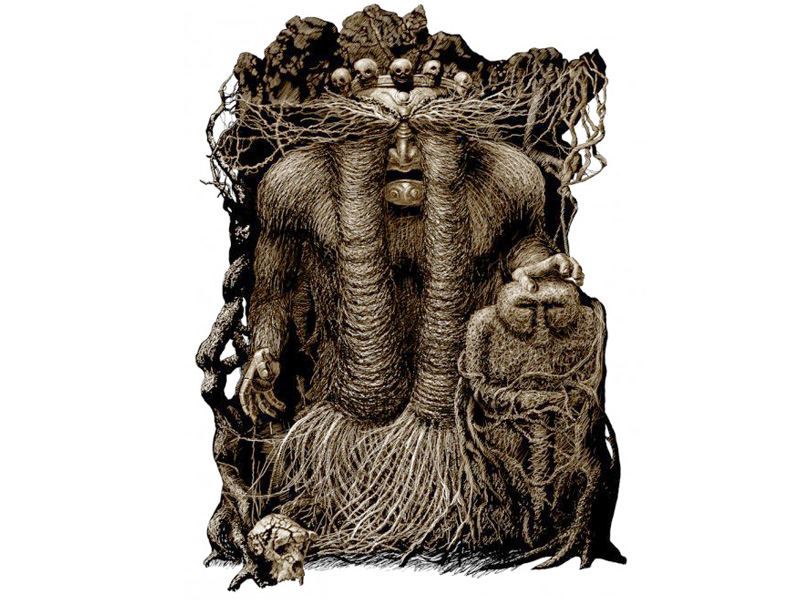
The question about “scary things” in children’s literature always comes up with an audience concerned with issues around reading. It’s as inevitable as the question about restricted topics and banned books. Why should we scare kids? Why do we need “scary” things in books? Are children’s books and “scary” things even compatible as concepts? Wouldn’t it be better if authors created works full of “light and kindness”? For the little ones, at least. And for the teenagers while they’re at it... In other words, “scary” things in books is a hot topic. I’ve wanted to make sense of it for a while now.
What is fear?
Fear is the defense mechanism of an organism capable of foreseeing pain. Pain is a signal of destruction. And fear is what precedes pain; it is a reaction to danger and a call to action, whether it’s fight or flight.
In the course of evolution, fear appears rather late. A common amoeba, for instance, is absolutely fearless. After all, it doesn’t have a nervous system to feel pain. An earthworm does feel pain—thanks to its nervous system, but then it doesn’t have a brain or psyche. That’s why it cannot foresee pain or experience fear. Cats, dogs, birds—they, on the other hand, know what it means to be scared.
Fear occurs in animals with a psyche (which in turn requires having a brain). The more advanced the brain and complex the psyche, the more developed the animal’s ability to foresee trouble and the more complex its “system” of fear becomes. There are certain types of fears that are passed down genetically: the reaction to loud noises or to shadows looming overhead, for instance.
Why does a rabbit fear shadows approaching from above? Because a predatory bird can strike from the sky. It attacked the rabbit’s distant ancestors in the exact same way and those ancestors learned that shadows represent danger, that shadows should be avoided. And so all the descendants fear shadows from birth.
Our ability to foresee danger is also a learned behavior. Any children’s book about animals will depict the mother teaching the little protagonist to recognize danger in time. What does it mean to recognize danger? It means that the mother teaches her offspring to experience fear.
Another important note: the higher the animal is on the evolutionary ladder, the greater the role of individual experience—an animal’s own story of lived pain and subsequent avoidance, a personal history of trauma, and ideas about danger. We see this in classic stories about animals’ lives—White Fang, The Biography of a Silver-fox, and others.
When it comes to people, things are even more complex. People’s fears are also concerned with the preservation and survival of their tribe, their family, their nation—those “social organisms” with which a person identifies and of which he forms a part. For example, murder or theft threaten the well-being of the community, and can ultimately tear it apart. They are something that should be feared; they are not to be allowed. The fear of such destruction lies at the core of the commandments “thou shalt not kill” and “you shalt not steal.” It’s not just the conscience of a person that serves as a guarantee of adherence, but also individual fear of the penalty that a violation will entail.
Of course, this is a rough framework. I simply want to show that fear is very important. It’s not a categorically negative concept. One of the objectives facing human culture is to teach a person to fear—to fear various phenomena, wild animals, other people, higher powers, something within himself....
We can read of fear in the legends of primitive hunters, in ancient myths and in fairy tales, in Greek and Roman lore about gods, titans, and heroes, and in the Old Testament. These are stories about encounters and clashes with that which is greater than you, which possesses an incredible, devastating power. These stories chart the boundaries of the safe territory for human existence and describe the consequences of violating those boundaries. “Fear of God” is about this. The word “God-fearing,” too.
In other words, culturally-speaking, fear plays the role of a regulatory framework, which governs both behavior and the course of thought. This means that socialization, growing into a social environment, demands that we absorb a sort of “pantheon of fears” along with cultural restrictions.
As an art form, literature has always been up to the task.
So why should books for children be free of it?
Taming fear
Even so, culture, and literature in particular, doesn’t only teach us to be afraid. It also teaches us to overcome fears.
Fear can lead to the destructive effects it is supposed to alert us to. Fear can engender neuroris, when the psyche is not able to deal with the pressure. Fear can even kill—when it is unbearable.
Culture, with the help of literature in particular, works to prevent those outcomes. It introduces fears into the “human dimension”—transmuting them into images and naming them. An image always has conditional boundaries consisting of what a person can perceive—can grasp with the imagination. Since ancient times, a name had magical power. Knowing someone’s name represented the opportunity to enter into a dialogue with its bearer. You could butter someone up, praise them, study them, tame them....
Culture has always been concerned with the taming of fears. It’s a challenge of the highest degree. And from today’s vantage point we can attest to several examples where it has succeeded.
Take, for instance, the image of the witch. A witch is the name of a powerful fear. For the medieval consciousness, the witch is associated directly with the Devil, with cardinal sins, and with threats to the body and the soul. That is how she appears in folklore, in the Brothers Grimm, and in the tales collected by Alexander Afanasyev. And the stories destroy the witch in the cruelest way possible: she is forced to dance in red-hot iron shoes; she is tied to a horse’s tail with the horse let loose in an open field; she is torn to pieces, and so on. In that fictional cruelty, which appears excessive today, there is a satisfaction of the ancient human fear before the power of the witch and her inhuman nature. That, strange as it may seem, is a psychotherapeutic approach: “draw your fear and tear up the sheet.”
With Hans Christian Andersen, the witch suffers a significant loss in her power. More specifically, she loses qualities like cannibalism, the ability to change forms, the direct connection to the Devil, etc., and acquires the characteristics of a “woman who can do magic.”
In the 20th century it is children’s literature that delivers the final blow to the power of witches. A new character appears in children’s books—a “little witch” or a “witch child” (recall The Little Witch by Otfried Preussler or Annie M.G. Schmidt’s little witch). This is none other than the taming of the fear called “witch.” It’s impossible to be terribly afraid of someone that behaves like a child—that has acquired such recognizable human traits and that can be so vulnerable. After all, “childishness” is not just vulnerable, but amusing. We simply can’t be terribly afraid of something funny. To laugh at the witch means to rob her of her power.
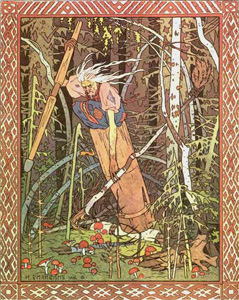
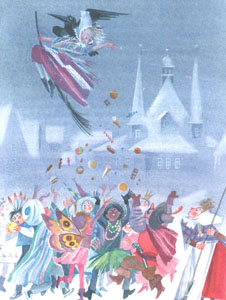
Actually, the whole swarm of “little evil spirits” that appeared in twentieth century children’s literature—all kinds of baby house spirits, baby water spirits, baby forest spirits, and so on—is proof of having overcome certain pagan fears that carry these names. Just as shards of ancient rituals become children’s games, so too do the images of terrible, otherworldly powers, which once inspired awe in people, become the characters of children’s stories. It appears, at this given step in our civilization’s development, even a child’s psyche can easily deal with them.
As a result, the vast majority of modern children are no longer scared of Baba Yaga. That is, the image of Baba Yaga and her name no longer elicit purely terrifying associations—that’s how completely this image has been mastered by culture: transformed, torn from the ancient myth, humanized, and even made into a laughing-stock. So too are mermaids more likely associated with something crude and erotic, than with something scary. What kind of threat is the classic warning that they will “tickle you to death”?
We are no longer comfortable reading about those means of “neutralizing” witches that the Brothers Grimm so vividly describe. We genuinely ask, “Why’d they do that to them?”
Maybe we should see this is as a sign that our culture is making progress in becoming more humanized….
Monsters and transformers
Forest spirits and house spirits, as we’ve already said, adopted the form of charming “childishness” and so modern adults make peace with them. What adults are still entirely unwilling to accept are robots and monsters, werewolves and vampires, various monsters of “cosmic origin.” “Those things” excite furious indignation and are seen only as harmful “hostile elements” that are foreign to our culture, appropriated from elsewhere. Many adults believe they contribute to rising aggression and cruelty among children. And leaders in the teaching community will periodically call for these characters to be banned in all their manifestations, whether in books, cartoons, or toys.
A few years ago, Swedish psychologists attended a seminar held at Moscow City Pedagogical-Psychological University’s Center for Games and Toys. At the seminar, the experts were to discuss, among other things, the issue of evaluating toys. The Center’s psychologist showed the guests a cabinet housing a collection of “bad toys.” On display behind the glass were all sorts of monster-transformers, these tech-creatures with clamps for hands and headlights for eyes. According to the organizers of the seminar, it was impossible to play with all that. The Swedes did not see it that way, however. “What do you mean, you can’t play with these?” One of them opened the glass door of the cabinet, pulled out a monster (half of its “face” was a sort of embedded control panel) and started to… rock him. He leaned down to him, as to a beloved child, and started to mumble something in Swedish, looking at us out of the corner of his eye, smiling. Then he put the monster back and said, no longer smiling:
“You see, in these ugly images you can catch sight of ancient motives, from the old magic stories.”
Of course, we’re all familiar with the many variations on the plot of “Beauty and the Beast.” We’ll set aside Godzilla, along with certain Hollywood inventions. Russian classic literature knows this plot as written by Sergey Aksakov in “The Little Red Flower.” In his rendition, the story is a beautiful ode to love. But it is actually one of a series of magical stories about entering into union with bears, frogs, ducks, snakes or, to put it plainly, shape-shifters. (I can’t help but imagine I might be accused of advertising bestiality here. But, first of all, these texts are accepted cultural treasures. Second, culture historians consider the stories shards of ancient totem myths.) At the core of all these tales lies the recognizable plot about taming a frightening, inhuman force.
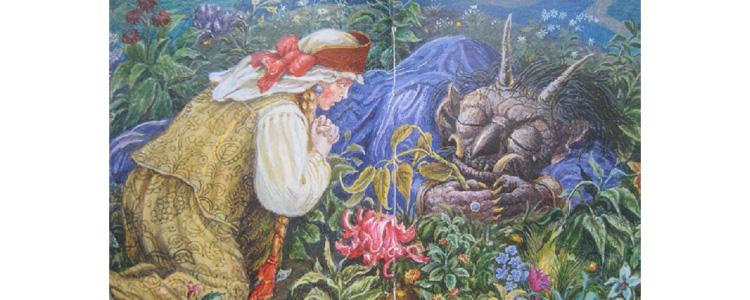
The fact that today that power takes the form of robots and transformers is just a reflection of our time in an era of new technologies. In place of a forest creature or sea monster, we now have a robot with rocket launchers for hands and a red button for a heart. A new time breeds new fears. Or, to be more precise, old fears transform themselves, taking new forms. A new form demands a new “name,” as well as a new “body,” which will allow us, as before, to tame that fear. At their core, powerful robots and spider-men have quite a bit in common with the “illegitimate” children of Greek gods, like Achilles and Perseus.
Love for the horrible
Recently, I paid an author’s visit to one of the children’s libraries in the Kaliningrad region, presumably to meet with readers. I came into the small function room and saw children with a sort of particular mark on their faces: as though they hadn’t washed their faces properly, or had been sick for a long time with some strange illness. If they had been adults, I would have guessed they were recovering from alcoholism. I looked at these “readers” and realized they were from an orphanage. The children were ten to twelve years old. It seemed unlikely that they had ever voluntarily read for pleasure. So I shifted gears.
“What do you think, what are some good book topics?
They answered:
“Vampires! The Devil! Werewolves!”
They say those words like they’re sweet to the taste.
“Would you like to hear about all of those?”
“Yes! We do-o-o!”
“Alrighty then… Let’s start with the Devil….”
I started telling them about the Devil (in a variation on the “The Pied Piper”), then about werewolves (about totems and shamanism), and about vampires (a brief introduction to physiology, explaining the northern hunters’ tradition of drinking the blood of the animal they have just killed). The teachers who had brought the children to the event looked a bit tense (they had been promised a decent guest, and she’s off talking about vampires), but they did note I had held the children’s attention for almost forty minutes—a record. I marked a check-box mentally.
But really, behind the request for devilish things of every stripe lies deformed emotional development. In their current lives, and likely the lives they had before, there is often a deficit of emotions, particularly positive emotions, and certainly delicate ones. There isn’t much that can fill that deficit at the orphanage, little that works to add nuance and complexity to the emotional world. Emotional development, in turn, is closely tied to attention, especially at a young age. As a result, these children also have difficulty focusing. In order to keep their attention, there needs to be a strong and simple stimulus.
It has to be recognizable, as well. Characters that live at the borders of our human world, representing perverted, distorted, upside-down relationships between each other and people—that, unfortunately, is recognizable for many kids. The ugliness and cruelty of the characters should surpass what these kids have themselves encountered. The fact that vampires and werewolves are also outcasts of human society allows for children to more easily identify with them. Besides, they represent a powerful force that others fear, another reason to identify with them. Essentially, we have a range of issues here.
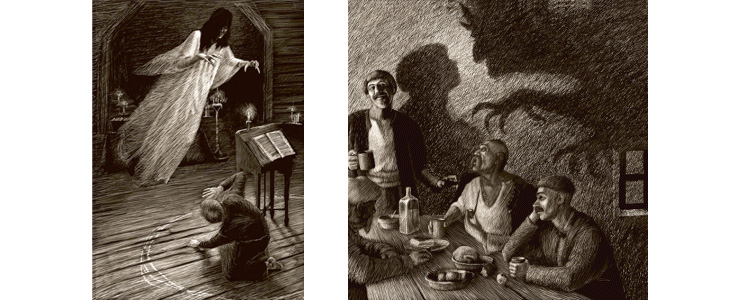
All this is bad not from the standpoint of morality but from the point of view of the children’s psychological state. Clearly, the given situation merited a diagnosis. If certain kids need this sort of verbal material (and evidently they do need it), it means that this verbal culture can only reach them in this way. Only targeted long-term efforts can help shift these children’s perception. In any case, it’s not images of vampires that we should be fighting here.
Overall, whether a book has vampires or other representatives of “horror” is not in and of itself an indication of the work’s literary quality. The great Russian writer Nikolai Gogol rose to fame, as we know, with short stories from the collection Evenings on a Farm Near Dikanka and Mirgorod. Pure horror, I’d say.
Marina Aromshtam
Translated from the Russian by Alisa Cherkasova
Follow us on Facebook.
